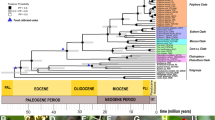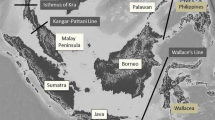Abstract
Phylogeographic lineages are interpreted as the product of repeated isolation in glacial refugia, leading to vicariant differentiation. Being restricted to a given geographic area could also promote adaptive divergence in response to local conditions. The role of phylogeny and climate in the evolution of the bank vole (Myodes glareolus) was investigated here, focusing on molar tooth shape, a morphological feature related to the exploitation of food resources. A balanced role of phylogeny and climate was demonstrated. Response to environmental factors led to morphological convergence of bank voles from different lineages living in similar environments, and to within-lineage divergence in extreme environments. An important interaction of climate and phylogeny was found, suggesting that each lineage is living in a particular environment. This lineage-specific adaptation to a range of environmental conditions may have conditioned the potential of post-glacial recolonization of each lineage. Morphological covariation with environmental conditions further highlights the potential of adaptation of this species.





Similar content being viewed by others
References
Abellán P, Svenning J-C (2014) Refugia within refugia – patterns in endemism and genetic divergence are linked to late Quaternary climate stability in the Iberian peninsula. Biol J Linn Soc 113:13–28
Akaike H (1973) Information theory as an extension of the maximum likelihood principle. In: Kiado A (ed) Second International Symposium on Information Theory, Budapest, pp 267–281
Amori G, Hutterer R, Kryštufek B, Yigit N, Mitsain G, Palomo LJ, Henttonen H, Vohralík V, Zagorodnyuk I, Juškaitis R, Meinig H, Bertolino S (2008) Myodes glareolus. The IUCN Red List of Threatened Species 2008: e.T4973A11104409. doi:10.2305/IUCN.UK. 2008.RLTS.T4973A11104409.en
Bonhomme V, Picq S, Gaucherel C, Claude J (2014) Momocs: outline analysis using R. J Statistical Software 56:1–24
Caumul R, Polly PD (2005) Phylogenetic and environmental components of morphological variation: skull, mandible, and molar shape in marmots (Marmota, Rodentia). Evolution 59:2460–2472
Colangelo P, Aloise G, Franchini P, Annesi F, Amori G (2012) Mitochondrial DNA reveals hidden diversity and an ancestral lineage of the bank vole in the Italian peninsula. J Zool 287:41–52
Cornetti L, Lemoine M, Hilfiker D, Morger J, Reeh K, Tschirren B (2016) Higher genetic diversity on mountain tops: the role of historical and contemporary processes in shaping genetic variation in the bank vole. Biol J Linn Soc 118:233–244
Darriba D, Taboada GL, Doallo R, Posada D (2012) jModelTest 2: more models, new heuristics and parallel computing. Nature Methods 9:772
Deffontaine V, Ledevin R, Fontaine MC, Quéré J-P, Renaud S, Libois R, Michaux JR (2009) A relict bank vole lineage highlights the biogeographic history of the Pyrenean region in Europe. Mol Ecol 18:2489–2502
Deffontaine V, Libois R, Kotlík P, Sommer R, Nieberding C, Paradis E, Searle JB, Michaux JR (2005) Beyond the Mediterranean peninsulas: evidence of central European glacial refugia for a temperate forest mammal species, the bank vole (Clethrionomys glareolus). Mol Ecol 14:1727–1739
Dodélec S, Chessel D (1994) Co-inertia analysis: an alternative method for studying species–environment relationships. Freshwater Biol 31:277–294
Dray S, Chessel D, Thioulouse J (2003) Co-inertia analysis and the linking of ecological data tables. Ecology 84:3078–3089
Dray S, Dufour A-B (2007) The ade 4 package: implementing the duality diagram for ecologists. J Statistical Software 22:1–20
Eronen JT, Rook L (2004) The Mio-Pliocene European primate fossil record: dynamics and habitat tracking. J Hum Evol 47:323–341
Filipi K, Marková S, Searle JB, Kotlík P (2015) Mitogenomic phylogenetics of the bank vole Clethrionomys glareolus, a model system for studying end-glacial colonization of Europe. Mol Phylogen Evol 82: 245–257
Freudenthal M (1972) Deinogalerix koenigswaldi nov. gen., nov. spec., a giant insectivore from the Neogene of Italy. Scripta Geologica 14:1–19
Freudenthal M (1976) Rodent stratigraphy of some Miocene fissure fillings in Gargano (prov. Foggia, Italy). Scripta Geologica 37:1–23
Gómez A, Lunt DH (2007) Refugia within refugia: patterns of phylogeographic concordance in the Iberian peninsula. In: Weiss S, Ferrand N (eds) Phylogeography of Southern European Refugia. Evolutionary Perspectives on the Origins and Conservation of European Biodiversity. Springer Netherlands, pp 155–188
Gouy M, Guindon S, Gascuel O, Lyon D (2010) SeaView version 4: a multiplatform graphical user interface for sequence alignment and phylogenetic tree building. Mol Biol Evol 27:221–224
Guérécheau A, Ledevin R, Henttonen H, Deffontaine V, Michaux JR, Chevret P, Renaud S (2010) Seasonal variation in molar outline of bank voles: an effect of wear? Mammal Biol 75:311–319
Guindon S, Dufayard J-F, Lefort V, Anisimova M, Hordijk W, Gascuel O (2010) New algorithms and methods to estimate maximum-likelihood phylogenies: assessing the performance of PhyML 3.0. Syst Biol 59:307–321
Herman JS, Jóhannesdóttir F, Jones EP, McDevitt AD, Michaux JR, White TA, Wójcik JM, Searle JB (2016) Post-glacial colonization of Europe by the wood mouse, Apodemus sylvaticus: evidence of a northern refugium and dispersal with humans. Biol J Linn Soc in press
Hewitt GM (1999) Post-glacial re-colonization of European biota. Biol J Linn Soc 68:87–112
Hijmans RJ, van Etten J (2014) raster: geographic data analysis and modelling. R package
Keller SR, Taylor DR (2008) History, chance and adaptation during biological invasion: separating stochastic phenotypic evolution from response to selection. Ecology Letters 11:852–866
Kotlík P, Deffontaine V, Mascheretti S, Zima J, Michaux JR, Searle JB (2006) A northern glacial refugium for bank voles (Clethrionomys glareolus). Proc Natl Acad Sci USA 103:14860–14864
Kryštufek B, Klenovšek T, Amori G, Janžekovič F (2015) Captured in 'continental archipelago': phylogenetic and environmental framework of cranial variation in the European snow vole. J Zool 297:270–277
Kuhl FP, Giardina CR (1982) Elliptic Fourier features of a closed contour. Computer Graphics and Image Processing 18:259–278
Ledevin R, Chevret P, Ganem G, Britton-Davidian J, Hardouin EA, Chapuis J-L, Pisanu B, Mathias MdL, Schlager S, Auffray J-C, Renaud S (2016) Phylogeny and adaptation shape the teeth of insular mice. Proc Roy Soc Lond Biol Sc (ser B) 283:20152820
Ledevin R, Michaux JR, Deffontaine V, Henttonen H, Renaud S (2010a) Evolutionary history of the bank vole, Myodes glareolus (Rodentia : Arvicolinae): a morphometric perspective. Biol J Linn Soc 100:691–694
Ledevin R, Quéré J-P, Renaud S (2010b) Morphometrics as an insight into processes beyond tooth shape variation in a bank vole population. PLoS One 5:e15470
Leigh JW, Bryant D (2015) POPART: full-feature software for haplotype network construction. Methods in Ecol Evol 6:1110–1116
Lenormand T (2002) Gene flow and the limits to natural selection. Trends Ecol Evol 17:183–189
Masini F, Petruso D, Bonfiglio L, Mangano G (2008) Origination and extinction patterns of mammals in three central western Mediterranean islands from the late Miocene to Quaternary. Quaternary Internatl 182:63–79
Michaux J, Chevret P, Renaud S (2007) Morphological diversity of Old World rats and mice (Rodentia, Muridae) mandible in relation with phylogeny and adaptation. J Zool Syst Evol Res 45:263–279
Michaux JR, Magnanou E, Paradis E, Nieberding C, Libois R (2003) Mitochondrial phylogeography of the woodmouse (Apodemus sylvaticus) in the western Palearctic region. Mol Ecol 12:685–697
Navarro N, Zatarain X, Montuire S (2004) Effects of morphometric descriptor change on statistical classification and morphospaces. Biol J Linn Soc 83:243–260
Paradis E, Claude J, Strimmer K (2004) APE: analyses of phylogenetics and evolution in R language. Bioinformatics 20:289–290
Parra V, Loreau M, Jaeger J-J (1999) Incisor size and community structure in rodents: two tests of the role of competition. Acta Oecol 20:93–101
Piras P, Marcolini F, Raia P, Curcios MT, Kotsakis T (2009) Testing evolutionary stasis and trends in first lower molar shape of extinct Italian populations of Terricola savii (Arvicolidae, Rodentia) by means of geometric morphometrics. J Evol Biol 22:179–191
R core team (2015) R: A language and environment for statistical computing. R Foundation for Statistical Computing, Vienna
Renaud S, Chevret P, Michaux J (2007) Morphological vs. molecular evolution: ecology and phylogeny both shape the mandible of rodents. Zool Scripta 36:525–535
Renaud S, Dufour A-B, Hardouin EA, Ledevin R, Auffray J-C (2015a) Once upon multivariate analyses: when they tell several stories about biological evolution. PLoS One 10:e0132801
Renaud S, Michaux JR (2007) Mandibles and molars of the wood mouse, Apodemus sylvaticus (L.): integrated latitudinal signal and mosaic insular evolution. J Biogeogr 34:339–355
Renaud S, Michaux J, Jaeger J-J, Auffray J-C (1996) Fourier analysis applied to Stephanomys (Rodentia, Muridae) molars: nonprogressive evolutionary pattern in a gradual lineage. Paleobiology 22:255–265
Renaud S, Michaux J, Schmidt DN, Aguilar J-P, Mein P, Auffray J-C (2005) Morphological evolution, ecological diversification and climate change in rodents. Proc Roy Soc Lond, Biol Sc (ser B) 272:609–617
Renaud S, Quéré J-P, Michaux JR (2015b) Biogeographic variations in wood mice: testing for the role of morphological variation as a line of least resistance to evolution. In: Cox PG, Hautier L (eds) Evolution of the Rodents: Advances in Phylogeny, Paleontology and Functional Morphology. Cambridge University Press, Cambridge, pp 300–322
Renvoisé E, Montuire S, Richard Y, Quéré J-P, Gerber S, Cucchi T, Chateau-Smith C, Tougard C (2012) Microevolutionary relationships between phylogeographical history, climate change and morphological variability in the common vole (Microtus arvalis) across France. J Biogeogr 39:698–712
Rohlf FJ, Archie JW (1984) A comparison of Fourier methods for the description of wing shape in mosquitoes (Diptera: Culicidae). Syst Zool 33:302–317
Schlager S (2014) Morpho: calculations and visualizations related to geometric morphometrics. R package
Taberlet P, Fumagalli L, Wust-Saucy A-G, Cosson J-F (1998) Comparative phylogeography and postglacial colonization. Mol Ecol 7:453–464
Tesakov A (1996) Evolution of bank voles (Clethrionomys, Arvicolinae) in the late Pliocene and early Pleistocene. Acta Zool Cracoviensia 39:541–547
Tougard C, Renvoisé E, Petitjean A, Quéré J-P (2008) New insight into the colonization processes of common voles: inferences from molecular and fossil evidence. PLoS One 3:1–10
Travisano M, Mongold JA, Bennet AF, Lenski RE (1995) Experimental tests of the roles of adaptation, chance, and history in evolution. Science 267:87–90
Tropeano M, Sabato L, Pieri P (2002 ) Filling and cannibalization of a foredeep: the Bradanic trough, southern Italy. Geol Soc Lond Spec Publ 191:55–79
White TA, Perkins SE, Heckel G, Searle JB (2013) Adaptive evolution during an ongoing range expansion: the invasive bank vole (Myodes glareolus) in Ireland. Mol Ecol 22:2971–2985
Wójcik JM, Kawałko A, Marková S, Searle JB, Kotlík P (2010) Phylogeographic signatures of northward post-glacial colonization from high-latitude refugia: a case study of bank voles using museum specimens. J Zool 281:249–262
Acknowledgements
We thank Frank Sauvage and Jean-Pierre Quéré for having provided some of the bank voles considered in this study. The comments of Jeremy Searle and an anonymous reviewer contributed to improve this manuscript. ZH was supported by Tübitak (The Scientific and Technological Research Council of Turkey). The project EDENext supported the collection of some specimens included in this study.
Author information
Authors and Affiliations
Corresponding author
Electronic supplementary material
Supplementary Figure 1:
Maximum likelihood phylogeny for the dataset with a genetic/morphometric match. The bootstrap support of the main lineages is indicated. (TIFF 102008 kb)
Supplementary Table 1:
Dataset used for the analyses. Specimen and Code: identification of the specimens. CF_A2 to CF_D10: Fourier coefficients. PC1 to PC5: scores along the first five PCs of the morphometric analysis. CA1 to CA10: scores of the canonical variate analysis on the Fourier coefficients. PCOA1 to PCOA5: scores on the axes of the PCOA on the phylogenetic data. PCclim1 to PCclim5: scores on the axes of the PCA on the bioclimatic data. (XLS 219 kb)
Rights and permissions
About this article
Cite this article
Ledevin, R., Chevret, P., Helvaci, Z. et al. Bank Voles in Southern Eurasia: Vicariance and Adaptation. J Mammal Evol 25, 119–129 (2018). https://doi.org/10.1007/s10914-016-9368-3
Published:
Issue Date:
DOI: https://doi.org/10.1007/s10914-016-9368-3




